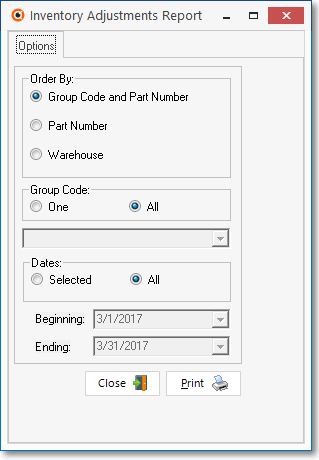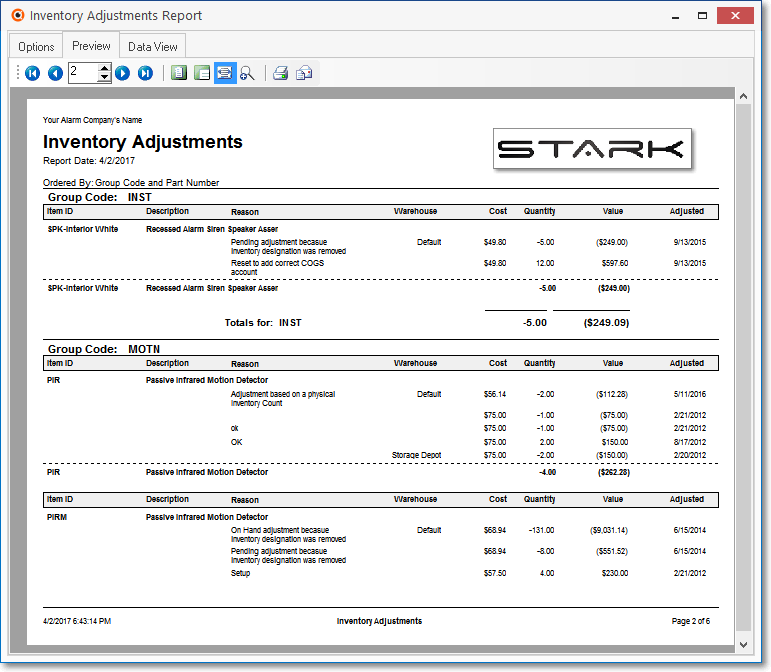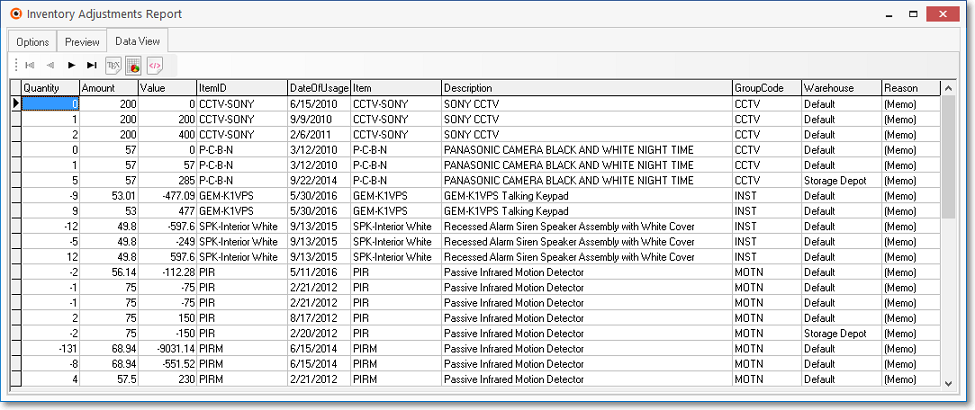❑The Edit Warehouse Inventory Values Form allows you to adjust one or more of the Inventory Count(s) for an Inventory Item.
•These Inventory Count(s) are displayed in the Warehouse Inventory Form and the Sale-Purchase Item Form.
•Inventory Adjustments are usually required based on the results of a physical Inventory count.
✓A record of the Inventory Adjustment is created and may be reviewed later using this Inventory Adjustments Report.
•To access the Inventory Adjustments Report:
a)From the Backstage Menu System Select Reports then Choose Inventory Reports and Select the Inventory Adjustments option, or
b)From the Quick Access Menu, Select Reports then Choose Inventory Reports and Select the Inventory Adjustments option
❑Inventory Adjustments Report tabs - There are three tabs on the Inventory Adjustments Report dialog.
•Options - Initially only the Options tab is shown (until you make your Options selections and Select Print).

Inventory Adjustments Report - Options tab
✓Order By - Choose the order in which the Inventory Adjustment records should be listed.
▪Group Code and Part Number - List the Group Code and then within that Group Code, List the Inventory Adjustment records in Part Number Order (Item ID).
➢Note: The Group Code refers to the "Part Group" Code that may be assigned in the Part Group field within the Inventory Info section of the Sale-Purchased Item Form. The Part Group Code may have 1 - 4 characters, and letters in the Code will be capitalized.
▪Part Number - List the the Inventory Adjustment records in Part Number order.
▪Warehouse - List the the Inventory Adjustment records in Warehouse Order, then within each Warehouse, in Part Number (Item ID) order.
✓Group Code - If Group Code and Part Number order was selected above, by default, all Group Codes will be included, but you may include Inventory Adjustments for One specific Group Code, if needed.
▪All - By default, All Inventory Adjustments will be listed, regardless of Group Code or Part Number (Item ID).
➢Note: The Group Code refers to the "Part Group" Code that may be assigned in the Part Group field within the Inventory Info section of the Sale-Purchased Item Form. The Part Group Code may have 1 - 4 characters and letters in the Code should be capitalized.
▪One - Click this button to report Inventory Adjustments for only one Part Group Code.
oUse the Drop-Down Selection List to Choose the appropriate Part Group Code.
oThere is also an Unclassified option available to list those Inventory Item Part Numbers which have not been assigned a Part Group Code
✓Part Number - If Part Number order was selected, you may include Inventory Adjustments for All Part Numbers, or One specific Part Number (Item ID).
▪All - The default. All Inventory Adjustments will be listed, regardless of Part Number.
▪One - Click this button to report Inventory Adjustments for only one Part Number.
oUse the Drop-Down Selection List to Choose the appropriate Part Number.
✓Warehouse - If Warehouse order was selected, you may include Inventory Adjustments for All Warehouses, or One specific Warehouse.
▪One - Click this button to report Inventory Adjustments for only one Warehouse.
oUse the Drop-Down Selection List to Choose the appropriate Warehouse.
▪All - The default. All Inventory Adjustments will be listed, regardless of the Warehouse where they are stored.
✓Dates - You may report All Inventory Adjustments (based on the selections made above) or further limit them to a specified Date Range.
▪All - By default, All Inventory Adjustments will be reported, limited only by the selections made above.
▪Selected - By default, the Date Range offered will represent the most recently completed month.
oClick this Selected button to limit the reported Inventory Adjustment records to those within a Date Range (see below).
oBeginning - Use the Drop-Down Calendar/Date Entry field to Choose the Starting Date.
oEnding - Use the Drop-Down Calendar/Date Entry field to Choose the Ending Date.
✓Print - Click the Print button ![]() to Preview and optionally Print (to a File or a Printer) this Inventory Adjustment Report.
to Preview and optionally Print (to a File or a Printer) this Inventory Adjustment Report.
✓To Exit this Report dialog, Click the Close button ![]() toward the bottom of the Options tab.
toward the bottom of the Options tab.
•Preview - The Preview tab presents the report which resulted from the Options you've selected.
✓Up Arrow/Down Arrow - hi - Moves the report one line up, or one line down, respectively.
✓Page Up/Page Down - Moves the report to the previous or next page, respectively.

Inventory Adjustment Report - Preview tab
✓Home - ![]() - Using either the screen icon or your Keyboard's Home key, moves the report to the top of the first page.
- Using either the screen icon or your Keyboard's Home key, moves the report to the top of the first page.
✓End - ![]() - Using either the screen icon or your Keyboard's End key, moves the report to the bottom of the last page.
- Using either the screen icon or your Keyboard's End key, moves the report to the bottom of the last page.
✓Arrows - The arrows allow you to move back and forth, from page to page.
✓Number - Indicates the page number you are viewing.
▪You may also type in a specific page number, Press 8 Enter and that page will be displayed immediately.
▪If you enter an invalid page number, it will be ignored.
✓Fit To Page - Click the first button after the arrows to size a full page of the report to fit the screen.
✓Zoom To 100% - Click the second button after the arrows to display the page at 100% (of the printed view).
✓Fit To Page Width - Click the third button after the arrows to size the page of the report to fit the full width of the screen.
✓Zoom To Percentage - Click the fourth button after the arrows to re-size the page of the report by percentage.
![]()
▪When you Click the Zoom To Percentage button, the Percentage selector will be displayed.
▪You may then Click the Up or Down ‚ arrows to set the exact amount of Zoom you want.
✓Print - Click the Print button to Print (to a File or a Printer) ![]() the displayed Inventory Adjustment Report.
the displayed Inventory Adjustment Report.
✓Email - Click the Email button ![]() to send the Report to an Email Address of your choosing.
to send the Report to an Email Address of your choosing.
✓To Exit the Preview tab and Close this Report dialog Form, Click the Close box ![]() on the right at the top of the Preview tab.
on the right at the top of the Preview tab.
•Data View - This view provides a tabular (spreadsheet style) presentation of the selected data.

Inventory Adjustment Report - Data View tab
✓Arrows - Click the arrows to move through the record.
✓Export - Exporting the data from this Data View Form (note the "fly-over" help available on these buttons):
▪Export to CSV - Click the first button after the arrows to export the data to a Comma Separated Values (CSV) file format.
▪Export To Excel - Click the second button after the arrows to export the data to an Excel (.xls) file format.
▪Export To Html - Click the third button after the arrows to export the data to an HTML formatted file.
✓To Exit the Data View tab and Close this Report dialog Form, Click the Close box ![]() on the right at the top of the Data View tab.
on the right at the top of the Data View tab.